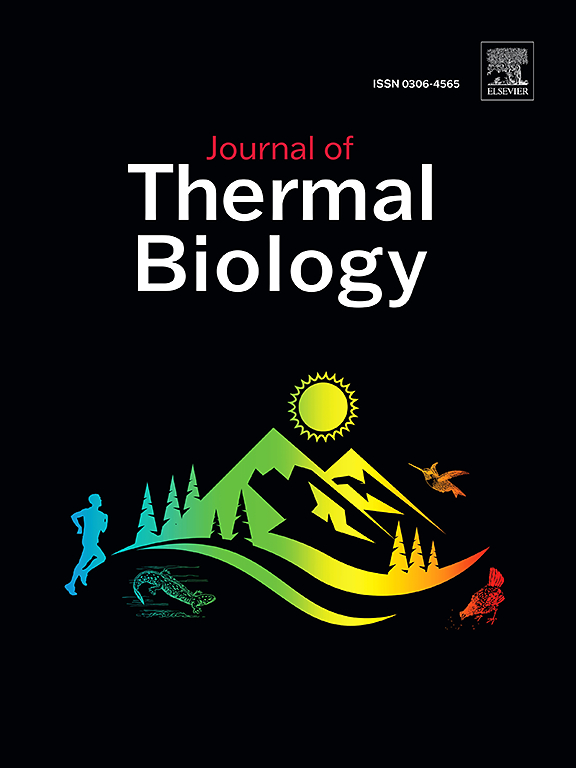绘制皮肤接触温度时空分布对人类手指热感的影响图
IF 2.9
2区 生物学
Q2 BIOLOGY
引用次数: 0
摘要
皮肤与热固体表面直接接触时的温度分布在人体生理反应中起着至关重要的作用,因为它影响热感觉和痛觉。本研究旨在利用一种创新的可视化技术,在受控热条件下与人体受试者直接接触保持在50 - 70℃固定温度(TH)的热固体表面时,促进对皮肤接触温度(TSC)及其在皮肤表面的空间分布的了解。结果显示,TSC空间总和的变化存在显著的性别差异,在TH水平升高时,男性受试者的TSC空间总和平均比女性受试者高4.2°C,而女性受试者的适应速度更快,导致疼痛发作时间更长。此外,本研究还探讨了皮肤性质(特别是皮肤厚度和皮肤粘弹性)对空间总温度(δ TSC,S)和热敏度变化的影响;研究结果表明,在中等TH时影响有限,在较高TH时影响微乎其微。这些见解对更安全的假肢、热装置和触觉技术的设计和开发具有重要意义。通过建立诸如将δ TSC,S值维持在10°C以下以减轻疼痛发作的指导方针,本研究为创建准确模拟人体对热输入的生理反应的系统提供了关键参数。未来的研究应该在不同的人群和动态条件下探索这些热心理物理反应,以扩大本工作所获得的见解的适用性。本文章由计算机程序翻译,如有差异,请以英文原文为准。
Mapping the influence of spatiotemporal distribution of skin contact temperature on perceived thermal sensation in human fingers
The temperature distribution upon direct skin contact with a hot solid surface plays a critical role in the resulting human physiological response as it influences both thermal sensation and pain perception. This study aims to advance understanding regarding the skin contact temperature (TSC) and its spatial distribution on the skin surface upon direct contact with a hot solid surface maintained at a fixed temperature (TH) ranging from 50 to 70 °C, using an innovative visualization technique under controlled thermal conditions with human subjects. Results highlight significant gender-based differences in changes in the spatial summation of TSC, with male subjects exhibit an average of 4.2 °C higher than that of female subjects at elevated TH levels, while females adapt faster, resulting in longer pain onset times. Additionally, this study explores the effects of skin properties, specifically skin thickness and skin viscoelasticity, on changes in the spatial summation temperature (delta TSC,S) and thermal sensitivity; the findings demonstrate limited influence at moderate TH, with marginal effects at higher TH. These insights have significant implications for the design and development of safer prosthetics, thermal devices, and haptic technologies. By establishing guidelines such as maintaining the delta TSC,S value below 10 °C to mitigate pain onset, this research provides critical parameters for creating systems that accurately mimic human physiological responses to thermal input. Future studies should explore these thermal psychophysical responses across diverse populations and dynamic conditions to broaden the applicability of the insights gained by the present work.
求助全文
通过发布文献求助,成功后即可免费获取论文全文。
去求助
来源期刊

Journal of thermal biology
生物-动物学
CiteScore
5.30
自引率
7.40%
发文量
196
审稿时长
14.5 weeks
期刊介绍:
The Journal of Thermal Biology publishes articles that advance our knowledge on the ways and mechanisms through which temperature affects man and animals. This includes studies of their responses to these effects and on the ecological consequences. Directly relevant to this theme are:
• The mechanisms of thermal limitation, heat and cold injury, and the resistance of organisms to extremes of temperature
• The mechanisms involved in acclimation, acclimatization and evolutionary adaptation to temperature
• Mechanisms underlying the patterns of hibernation, torpor, dormancy, aestivation and diapause
• Effects of temperature on reproduction and development, growth, ageing and life-span
• Studies on modelling heat transfer between organisms and their environment
• The contributions of temperature to effects of climate change on animal species and man
• Studies of conservation biology and physiology related to temperature
• Behavioural and physiological regulation of body temperature including its pathophysiology and fever
• Medical applications of hypo- and hyperthermia
Article types:
• Original articles
• Review articles
 求助内容:
求助内容: 应助结果提醒方式:
应助结果提醒方式:


